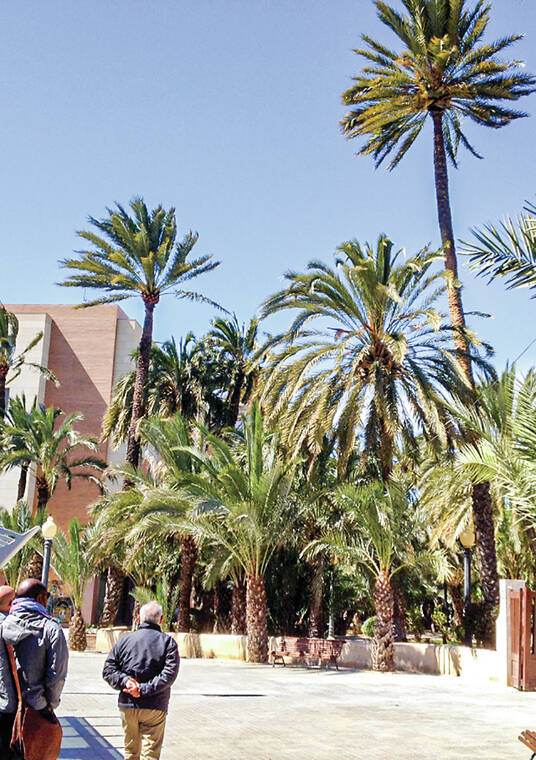This Sunday is Palm Sunday and is celebrated by Christians world wide. It is said to be the day that Jesus entered Jerusalem riding a donkey to celebrate Passover. He was greeted by a great crowd acclaiming him by waving date palm branches and shouting ”Hosanna,” “Blessed is he who comes in the name of the Lord.”
Date palms have been vital to early cultures of the Middle East and North Africa for thousands of years. The fruit is important to this day as part of the diet there and here as well. Date farms in the deserts of Southern California supply some of the best Medjool dates to be found in local markets. Date palms may be grown in dry low regions of the Big Island like North and South Kohala. The fruit is edible but not up to market standards.
Another popular palm is the coconut. When we think of the tropics, the first trees that come to mind are coconut palms gracing white coral sand beaches. Truly, these palms have been carried by humans throughout the tropical world over thousands of years. Taxonomists, botanists and anthropologists have attempted to discover the origin of this valuable tree, but none are sure. One theory is that the specie evolved in the Australasian region hundreds of thousands of years ago since some of the earliest records are indicative. They may even have evolved when the interior of Australia was ocean. At any rate, the coconut palm is one of our favorite trees in Hawaii for landscape purposes, food and shelter. However, there are many more palms species to be found here. They generally come in two types. These are the feather leaf or pinnate and the fan leaf or palmate. Of course, there are always exceptions like the Fishtail Palms or Caryota species with bipinnate leaves.
As far as the U.S. is concerned, the coconut palm can only be grown here and the southern tip of Florida.
When it comes to species of palms in the world, there are thousands with more discovered each year. They come from the high mountains like the Andean wax palms that live at 13,000 feet above sea level to equatorial rainforest species like those from the Amazon. Desert palms are another large group, but none is quite so close to our Hawaiian hearts as the coconut palm.
The coconut palm group is composed of scores of varieties including some dwarf types that should be used more in Hawaii. Not only are they shorter and easy to harvest, they are resistant to a devastating disease referred to as lethal yellowing. Unfortunately our endemic Loulu palms (Pritchardia species) are very prone to this disease. We do not want to accidentally introduce this disease.
Palms here have few serious diseases at present. Hawaii’s palms may be affected by bud rot or stem bleeding disease that is often caused by physical damage such as unsanitary pruning equipment or climbing spikes. Most palms showing yellow or stunted growth have been found to be suffering from lack of fertilizer or water. The trees simply need a balanced fertilizer plus minor elements, applied 3 to 4 times per year, and regular irrigation.
All these problems are correctable, but if lethal yellowing ever gets in Hawaii, there’s no practical way of stopping destruction of our island’s palms.
Not only would the coconut palm be destroyed, but over a hundred species of native and exotic palms would also die.
When lethal yellowing hit the mainland of Florida, it was discovered that many other palms species were also susceptible to the disease in varying degrees. Florida embarked on a two-stage program to replant the stripped areas. Over half a million dwarf coconuts were imported.
The dwarf, while highly resistant to the disease also had the added benefit of easily harvested nuts and did not require expensive nut and leaf removal as with the tall varieties. Hawaii is fortunate to be far from disease affected regions, so it is vital that we do not introduce this and other plant plagues.
We can also make every effort to use many of the hundreds of disease resistant species besides the coconut palm to grace our home landscapes, parks and scenic roadways.
We are fortunate to have several nurseries like Suchin and Jeff Marcus’s Floribunda nursery that have collected palms seed from all over the world for our parks and gardens.
It is important to cooperate with the Hawaii and Federal Departments of Agriculture and follow all the rules of inspection to keep our palms free of disease and insect pests.
Norman Bezona is professor emeritus, University of Hawaii College of Tropical Agriculture and Human Resources.






